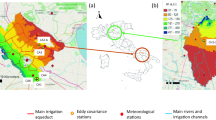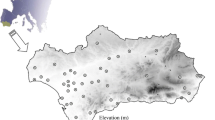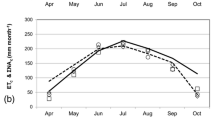Abstract
This paper analyses the performance of sub-optimal irrigation schedules obtained daily by solving a multi-objective optimization problem with updated weather measurements and forecasts. The approach was tested using five crops at four European locations with contrasting weather conditions. Four- and 6-day Global Forecast System (GFS) forecasts were used at all locations, and comparison with a down-scaled locally tuned model was conducted at one location. Accurate GFS temperature forecasts were observed at all four locations, but the accuracy of the potential evapotranspiration calculated from the GFS forecasts was not as consistent. Precipitations forecasts were very poor at all locations. In Greece, the down-scaled locally tuned forecasts were only marginally better than the GFS ones. In most cases, recomputing the sub-optimal irrigation schedule daily greatly reduced the impact of the imperfect weather forecasts on the final results. Using 4- or 6-day actual forecasts did not yield results appreciably better than those obtained using only historical averages as surrogate forecasts. The main consequence of the imperfect forecasts was that the final yield differed from the target one, but the (yield, irrigation) combination remained close to optimal, unless the target yield was set too high and water availability was not the main factor limiting crop development.








Similar content being viewed by others
References
Battilani A, Andersen MN, Plauborg F, Sylaios G, Tsakmakis I, Ramos T, Simionesei L, Martinez F, Jimenez Bello MA, Gips A (2016) Final report of work Package 8, FIGARO Project. http://www.figaro-irrigation.net/fileadmin/user_upload/figaro/docs/D8_2-8_3_Final1_2.pdf. Accessed 1 Oct 2018
Bergez JE, Deumier JM, Lacroix B, Leroy P, Wallach D (2002) Improving irrigation schedules by using a biophysical and a decisional model. Eur J Agron 16:123–135
Cai X, Hejazi MI, Wang D (2011) Value of probabilistic weather forecasts: assessment by real-time optimization of irrigation scheduling. J Water Resour Plan Manag 137:391–403
Delgoda D, Malano H, Saleem SK, Halgamuge MN (2016) Irrigation control based on model predictive control (MPC): formulation of theory and validation using weather forecast data and AQUACROP model. Environ Model Softw 78:40–53
Fang H, Liang S, Hoogenboom G, Teasdale T, Cavigelli M (2011) Crop yield estimation through assimilation of remotely sensed data into the CSM-CERES-Maize model. Int J Remote Sens 32:1039–1065
Garg NK, Dadhich SM (2014) Integrated non-linear model for optimal cropping pattern and irrigation scheduling under deficit irrigation. Agric Water Manag 40:1–13
Gowing JW, Ejieji CJ (2001) Real-time scheduling of supplemental irrigation for potatoes using a decision model and short-term weather forecast. Agric Water Manag 47:137–153
Hanji A, Ponnambalam K, Khalili D, Karamouz M (2006) A new stochastic optimization model for deficit irrigation. Irrig Sci 25:63–73
Hashemi F, Decker W (1969) Using climatic information and weather forecast for decisions in economizing irrigation water. Agric Meteorol 6:245–257
Hejazi MI, Cai X, Yuan X, Liang ZZ, Kumar P (2014) Incorporating reanalaysis-based short-term forecasts from a regional climate model in an irrigation scheduling optimization problem. J Water Resour Plan Manag 140:699–713
Hurley PJ, Luhar AK (2009) Modelling the meteorology at the Cabauw tower for 2005. Bound Layer Meteorol 132:43–57
Hurley PJ, Physick WL, Luhar AK (2005) TAPM: a practical approach to prognostic meteorological and air pollution modelling. Environ Model Softw 20:737–775
Ines AVM, Das NN, Hansen JW, Joku EG (2013) Assimilation of remotely sensed soil moisture and vegetation with a crop simulation model for maize yield prediction. Remote Sens Environ 138:149–164
Kuo SF, Liu CW (2003) Simulation and optimization model for irrigation planning and management. Hydrolog Process 17:3141–3159
Linker R, Ioslovich I (2015) A multi-year simulation study of optimal and sub-optimal irrigation of maize in Kansas. In: Proceedings of the ASABE annual meeting (New Orleans, USA). Paper 15-2182705
Linker R, Ioslovich I (2017) Assimilation of canopy cover and biomass measurements in the crop model AquaCrop. Biosyst Eng 162:57–66
Linker R, Sylaios G (2016) Efficient model-based sub-optimal irrigation scheduling using imperfect weather forecasts. Comput Electron Agric 130:118–127
Linker R, Ioslovich I, Sylaios G, Plauborg F, Battilani A (2016) Optimal model-based deficit irrigation scheduling using AquaCrop: a simulation study with cotton, potato and tomato. Agric Water Manag 163:236–243
Olioso A, Inoue Y, Ortega-Farias S, Demarty J, Wigneron JP, Braud I, Jacob F, Lecharpentier P, Ottle C, Calvet JC, Brisson N (2005) Future directions for advanced evapotranspiration modeling: assimilation of remote sensing data into crop simulation models and SVAT models. Irrig Drain Syst 19:377–412
Ramos T, Simionesei L, Jauch E, Almeida C, Neves R (2017) Modelling soil water and maize growth dynamics influenced by shallow groundwater conditions in the Sorraia Valley region, Portugal. Agric Water Manag 185:27–42
Seidel SJ, Schütze N, Fahle M, Mailhol JC, Ruelle P (2015) Optimal irrigation scheduling, irrigation control and drip line layout to increase water productivity and profit in subsurface drip-irrigated agriculture. Irrig Drain 64:501–518
Taylor KE (2001) Summarizing multiple aspects of model performance in a single diagram. J Geophys Res 106:7183–7192
Thorp KR, Wang G, West AL, Moran MS, Bronson KF, White JW, Mon J (2012) Estimating crop biophysical properties from remote sensing data by inverting linked radiative transfer and ecophysiological models. Remote Sens Environ 124:224–233
Tsakmakis I, Kokkos N, Pisinaras V, Papaevangelou V, Hatzigiannakis E, Arampatzis G, Gikas GD, Linker R, Zoras S, Evagelopoulos V, Tsihrintzis VA, Battilani A, Sylaios G (2017) Operational precise irrigation for cotton cultivation through the coupling of meteorological and crop growth models. Water Resour Manag 31:563–580
Vazifedoust M, Van Dam JC, Feddes RA, Feizi M (2008) Increasing water productivity of irrigated crops under limited water supply at field scale. Agric Water Manag 95:89–102
Wang D, Cai X (2009) Irrigation scheduling—role of weather forecasting and farmers’s behavior. J Water Resour Plan Manag 135:364–372
Zhou Z, Andersen MN, Plauborg F (2016) Radiation interception and radiation use efficiency of potato affected by different N fertigation and irrigation regimes. Eur J Agron 81:12–137
Zhou Z, Plauborg F, Kristensent K, Andersen MN (2017) Dry matter production, radiation interception and radiation use efficiency of potato in response to temperature and nitrogen application regimes. Agric Forest Meteorol 232:595–605
Acknowledgements
The research leading to these results has received funding from the European Community’s Seventh Framework Programme (FP7/2007–2013) under Grant agreement no. 311903-FIGARO (“Flexible and Precise Irrigation Platform to Improve Farm-Scale Water Productivity”) (http://www.figaro-irrigation.net/). The contents of this document are the sole responsibility of the FIGARO Consortium and can under no circumstances be regarded as reflecting the position of the European Union.
Author information
Authors and Affiliations
Corresponding author
Additional information
Communicated by J. William Knox.
Rights and permissions
About this article
Cite this article
Linker, R., Sylaios, G., Tsakmakis, I. et al. Sub-optimal model-based deficit irrigation scheduling with realistic weather forecasts. Irrig Sci 36, 349–362 (2018). https://doi.org/10.1007/s00271-018-0592-x
Received:
Accepted:
Published:
Issue Date:
DOI: https://doi.org/10.1007/s00271-018-0592-x




